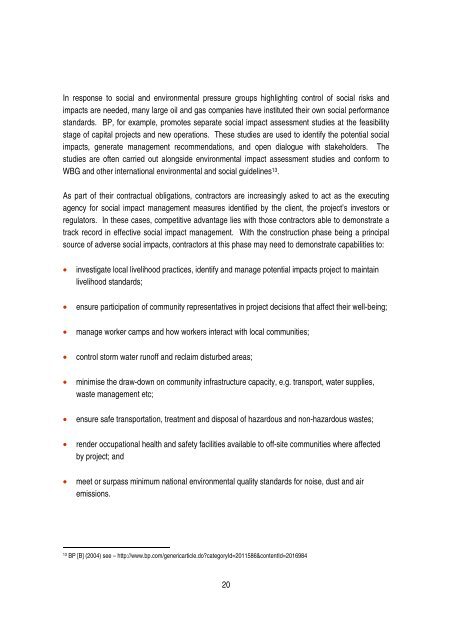In response to social <strong>and</strong> environmental pressure groups highlighting control of social risks <strong>and</strong>impacts are needed, many large oil <strong>and</strong> gas companies have instituted their own social performancest<strong>and</strong>ards. BP, for example, promotes separate social impact assessment studies at the feasibilitystage of capital projects <strong>and</strong> new operations. These studies are used to identify the potential socialimpacts, generate management recommendations, <strong>and</strong> open dialogue with stakeholders. Thestudies are often carried out alongside environmental impact assessment studies <strong>and</strong> conform toWBG <strong>and</strong> other international environmental <strong>and</strong> social guidelines 13 .As part of their contractual obligations, contractors are increasingly asked to act as the executingagency for social impact management measures identified by the client, the project’s investors orregulators. In these cases, competitive advantage lies with those contractors able to demonstrate atrack record in effective social impact management. With the construction phase being a principalsource of adverse social impacts, contractors at this phase may need to demonstrate capabilities to:• investigate local livelihood practices, identify <strong>and</strong> manage potential impacts project to maintainlivelihood st<strong>and</strong>ards;• ensure participation of community representatives in project decisions that affect their well-being;• manage worker camps <strong>and</strong> how workers interact with local communities;• control storm water runoff <strong>and</strong> reclaim disturbed areas;• minimise the draw-down on community infrastructure capacity, e.g. transport, water supplies,waste management etc;• ensure safe transportation, treatment <strong>and</strong> disposal of hazardous <strong>and</strong> non-hazardous wastes;• render occupational health <strong>and</strong> safety facilities available to off-site communities where affectedby project; <strong>and</strong>• meet or surpass minimum national environmental quality st<strong>and</strong>ards for noise, dust <strong>and</strong> airemissions.13BP [B] (2004) see – http://www.bp.com/genericarticle.do?categoryId=2011586&contentId=201698420
4.1.2 Maximising Local Socio-Economic BenefitsBeyond paying compensation to communities for lostassets, or for disruption <strong>and</strong> displacement, most oil <strong>and</strong>gas majors now invest in communities in ways that arenot easily integrated into their core business. Again,this is seen as part of operational risk management, butit is also driven by the need for a positive reputationwith opinion formers in the country of the parentcompany, e.g. the media, campaign groups <strong>and</strong>socially responsible investors. Some operators havegone to quite extreme lengths in this regard, effectivelybehaving as community development charities,providing livelihood enhancement projects, communityhealth <strong>and</strong> other local infrastructure. Some companiesprovide this assistance directly <strong>from</strong> within theirorganisation, others have established a local‘foundation’ managed <strong>and</strong> resourced by the company,<strong>and</strong> others still chose to outsource the work to localcommunity development NGOs. Box 2 gives twoexamples of typical community investment projects, inthis case managed by the Pilipinas Shell FoundationIncorporated (PSFI) on behalf of Shell PhilippinesExploration Company.Box 2Community Investment in the ShellMalampaya <strong>Gas</strong>-to-Power Project,PhilippinesExample 1Funded <strong>and</strong> managed by the Philipinas ShellFoundation (PSFI), a Social Development Program isbeing implemented for the five communities –Tabangao, Ambulong, Libjo, San Isidro, <strong>and</strong> Malitam –that surround the Shell Malampaya on-shore gas plant<strong>and</strong> the Tabangao refinery in Batangas. Theprogramme helps the communities (Barangays)develop self-reliance through five programcomponents, as follows:• employment generation <strong>and</strong> skills training• youth leadership training• livelihood <strong>and</strong> micro enterprise training for cocommunity-basedoperatives• health care• environmental clean-up of the Tabangao riverExample 2A Memor<strong>and</strong>um of Agreement (MOA) was signed inJuly 2000 between PSFI, SPEX (the operator), <strong>and</strong> theprovincial government of Oriental Mindoro (the isl<strong>and</strong>province next to the off-shore pipeline). The MOAprovide technical assistance to the isl<strong>and</strong> as follows:• training to fishing cooperatives in coastal resourcemanagement• training in fishing households to developalternative sources of income, e.g. hog raising• training to women <strong>and</strong> youth of Calapan City todevelop garment livelihood projectsWithin their quality submissions, although contractorsare increasingly required to demonstrate a track record in community dialogue, it is still rare for thefinal terms of a contract to require their participation in the types of community investment projectsdescribed above. This omission offers potential scope for market differentiation by contractors, inparticular for asset support <strong>and</strong> maintenance contracts where the contractor may be the onlyrepresentatives of the project ‘on-the-ground’ interacting with affected communities. The followingsteps are suggested as a route for contractors to identify how they might best assist their clientenhance its community investment performance:1. Within periodic project risks analysis processes identify the client’s priority operational risks thatrelate to local community factors, i.e. which assets might be affected, in what way, where, <strong>and</strong>which stakeholders are involved 14 ;14ODI <strong>and</strong> EAP (2004) Enhancing Social Performance through Risk Analysis, Briefing Note 1. London, Overseas DevelopmentInstitute.21















![[PDF] Community Development Toolkit - CommDev](https://img.yumpu.com/48616495/1/184x260/pdf-community-development-toolkit-commdev.jpg?quality=85)
